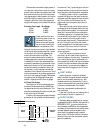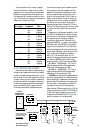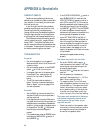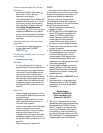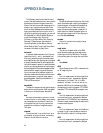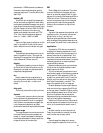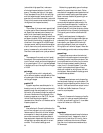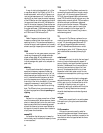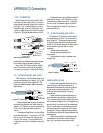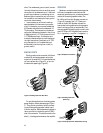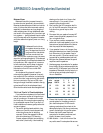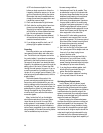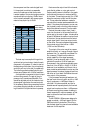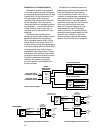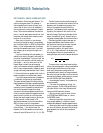32
Q
A way of stating the bandwidth of a filter
or equalizer section. An EQ with a Q of .75 is
broad and smooth, while a Q of 10 gives a nar-
row, pointed response curve. To calculate the
value of Q, you must know the center frequency
of the EQ section and the frequencies at which
the upper and lower skirts fall 3 dB below the
level of the center frequency. Q equals the cen-
ter frequency divided by the difference between
the upper and lower –3 dB frequencies. A peak-
ing EQ centered at 10kHz whose –3 dB points
are 7.5kHz and 12.5kHz has a Q of 2.
RFI
Radio Frequency Interference. High
frequency radiation that often results from
sparking circuits. This can be manifested in a
number of ways in audio systems, but is usually
evident as a high-frequency buzz or hash sound.
RMS
An acronym for root mean square, a conven-
tional way to measure AC voltage and audio
signal voltage. Most AC voltmeters are cali-
brated to read RMS volts. Other conventions
include average volts, peak volts, and peak-to-
peak volts.
shelving
A term used to describe the shape of an
equalizer’s frequency response. A shelving
equalizer’s response begins to rise (or fall) at
some frequency and continues to fall (or rise)
until it reaches the shelf frequency, at which
point the response curve flattens out and re-
mains flat to the limits of audibility. If you were
to graph the response, it would look like a
shelf. At least, more like a shelf than a hiking
boot. The EQ controls on your stereo are usu-
ally shelving equalizers. See also peaking and
dipping.
stereo
Believe it or not, stereo comes from a Greek
word that means solid. We use stereo or stereo-
phonic to describe the illusion of a continuous,
spacious soundfield that is seemingly spread
around the listener by two or more related au-
dio signals. In practice, stereo often is taken to
simply mean two channels.
sweep EQ
An equalizer that allows you to “sweep” or
continuously vary the affected frequency of one
or more sections.
TRS
Acronym for Tip-Ring-Sleeve, a scheme for
connecting three conductors through a single
plug or jack. 1⁄4" phone plugs and jacks and
1⁄8" mini phone plugs and jacks are commonly
wired TRS. Since the plug or jack can carry two
signals and a common ground, TRS connectors
are often referred to as stereo or balanced
plugs or jacks. Another common TRS applica-
tion is for insert jacks, used for inserting an
external processor into the signal path. In
Mackie mixers, the tip is send, ring is return,
and sleeve is ground.
TS
Acronym for Tip-Sleeve, a scheme for con-
necting two conductors through a single plug
or jack. 1⁄4" phone plugs and jacks and 1⁄8"
mini phone plugs and jacks are commonly
wired TS. Sometimes called mono or unbal-
anced plugs or jacks. A 1⁄4" TS phone plug or
jack is also called a standard phone plug or
jack.
unbalanced
An electrical circuit in which the two legs of
the circuit are not balanced with respect to
ground. Usually, one leg will be held at ground
potential. Unbalanced circuit connections re-
quire only two conductors (signal “hot” and
ground). Unbalanced audio circuitry is less
expensive to build but under certain circum-
stances is more susceptible to picking up noise.
unity gain
A circuit or system that has its voltage gain
adjusted to be one, or unity. A signal will leave
a unity gain circuit at the same level at which
it entered. In Mackie mixers, unity gain is
achieved by setting all variable controls to the
marked “U” setting. Mackie mixers are opti-
mized for best headroom and noise figures at
unity gain.
volume
Electrical or sound level in an audio system.
Perhaps the only thing that some bands have
too much of.
XLR connector
A three-pin connector used in audio for
transmitting a balanced signal. Sometimes re-
ferred to as a Cannon connector, named for the
manufacturer who first popularized the three-
pin connector.



